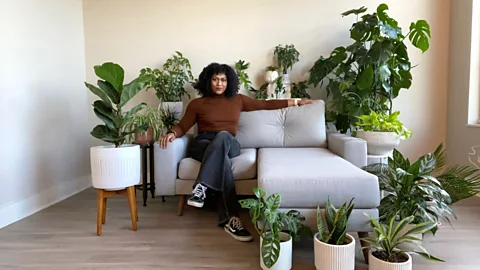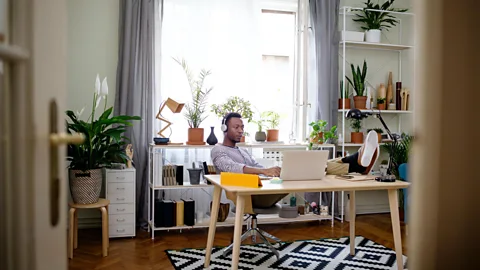How ‘biophilic’ design can create a better workspace
 MaSovaida Morgan
MaSovaida MorganIf you’re feeling less than enthused about working from home, one design philosophy could make you more productive – and, simply, happier.
When the pandemic padlocked international borders earlier this year, MaSovaida Morgan traded her itinerant life as a travel writer for a steady gig working remotely in Washington, DC for a tech company based in Silicon Valley. It was the first time in years that the 36-year-old had settled in one place for more than a few weeks, so she turned to houseplants to give her apartment a sense of serenity she often found on her adventures abroad.
“I really didn’t see it as frivolous,” she explains of her 25 newly-purchased plants. “If I’m going to be spending my entire existence in a 450-square-foot studio apartment, then it’s got to be a sanctuary for me where I can be productive, take a break and find peace.”
Fuelled by a boom in so-called ‘plantfluencers’ on Instagram, houseplant sales were skyrocketing among US millennials even before the pandemic, with a nearly 50% rise in sales between 2017 and 2019, according to the National Gardening Association. Now, many like Morgan see them as a necessary tool in fostering optimal work-from-home conditions.
Experts say this desire to fill indoor environments with objects from the outdoors ties in to the growing movement toward ‘biophilic design’, which is a concept used to increase wellbeing through both direct and indirect exposure to nature. Biophilic design was a major office trend in the years leading up to 2020, when Amazon introduced spherical conservatories to its Seattle headquarters; Microsoft debuted treehouse conference rooms in nearby Redmond, Washington; and Facebook created a 3.6-acre rooftop garden at its Silicon Valley hub.
 Alamy
AlamyDue to Covid-19, most of these offices are now closed – as are many around the globe – but that hasn’t stopped remote workers from bringing the concept back home with them. Thanks to the pandemic, millions of people now have the chance to create a work environment with their own wellbeing in mind. An increasing body of evidence shows that incorporating nature can help with things like decreasing stress and increasing productivity, creativity and attention span. To get the best results, however, fashionable houseplants are merely the first step in a more holistic multisensory approach.
Playing with light and colour
German psychoanalyst Erich Fromm first coined the term ‘biophilia’ in the 1960s to describe our instinctive tendency to seek connections with nature. The term ‘biophilic design’ didn’t gain prominence until the early 2000s as a way of intentionally fostering human-nature connections within manufactured environments, according to Perth-based scholar Jana Söderlund, author of The Emergence of Biophilic Design.
“It’s about bringing nature in all its forms – including patterns, materials, shapes, spaces, smells, sights and sounds – into urban design on varying scales,” she explains. “A lot of it is common sense because we’re innately and evolutionarily hardwired to respond to nature. We just need a reminder sometimes.”
Houseplants may be the most obvious starting point – though claims about their supposed air-purifying abilities are more hype than reality. In a months-long study conducted in two large commercial offices in the UK and The Netherlands, data showed that ‘green’ offices with plants made staff 15% more productive than ‘lean’ designs stripped of greenery.
Beyond adding greenery, Söderlund says that there are several other simple additions for optimising a home office, including light and colour. Natural light supports the circadian rhythms of the body, which regulate our sleep-wake cycle, as well as hormones. Those working in a windowless or dark environment can typically mimic natural light by incorporate a variety of lighting levels throughout the workday.
Adding an indirect experience with nature through earth tones can also have an array of positive psychological and physiological effects – as long as the colours represent what Söderlund calls “healthy nature”. “You don’t want to use colours that are indicative of dying plants, like an orangey-yellow hue,” she says. Instead, try forest greens, sky blues or savannah browns. “Look outside the window and think to yourself how you can bring those colours inside,” she adds.
Research has shown that certain colours actually alter work moods. Green, for example, can enhance creativity, while a warm yellow or red can trigger greater attention span. Similarly, studies show that adding art with natural fractal patterns can be a great tool for reducing stress.
 Alamy
AlamyA multisensory experience
Sonja Bochart, a leading biophilic design consultant based in Phoenix, in the US state of Arizona, says people often begin and end their outdoor-inspired office design with plants, “but it’s really about waking that multisensory experience you get in nature”.
Short interactions with non-rhythmic sensory stimuli – which are created by objects in constant yet unpredictable motion – have been shown to improve blood pressure and heart rate as well as have positive effects on the sympathetic nervous system. Bochart says you can incorporate this into a home office by adding waving grass outside a window or a fish bowl on a desk.
“I also like to advocate for the sense of aroma,” she says, “which you can get by opening a window, lighting a candle or using essential oils.”
One of the more overlooked components of biophilic design, she adds, is relics of nature. “These are simple things like seashells, geometric forms or stones that provide a tactile experience and also remind us to become curious like a child.”
‘A controlled, calm space’
Researchers are still studying the cumulative effect of all of these elements, but as a rule of thumb, experts like Bochart and Söderlund say that when things start to feel cluttered, you may have gone too far. The goal should be to trigger physical, emotional and cognitive responses through sustained engagement with nature as well as foster a positive connection with your workplace.
Taking daily walks in nature may replicate many of the multisensory benefits, but isn’t a viable alternative to an otherwise sterile office. “Sure, you can get benefit and value from being outside,” says Bochart, “but the fact is that most of us spend more than 90% of our time indoors, so there is an urgency to bring nature inside and to design with its patterns in mind.”
 Alamy
AlamyMorgan, the remote worker in Washington, DC, had never heard of biophilic design before she intentionally staged her home office with plants, linen furniture and ample natural light. She says it simply made her feel good, and also helps to project a soothing image to colleagues on daily video calls. “I want the energy to show through on the camera that I am in a controlled, calm space where I can be productive but also rest and have some serenity,” she says. Each work day starts by letting in natural light, saying hello to the plants (“they’re all named”) and placing a “productivity blend” of spearmint and lemongrass in an essential oil diffuser.
For the newly homebound employee, this multisensory biophilic experience is not just a trend amplified by Instagram – it could be the key to another successful day.
